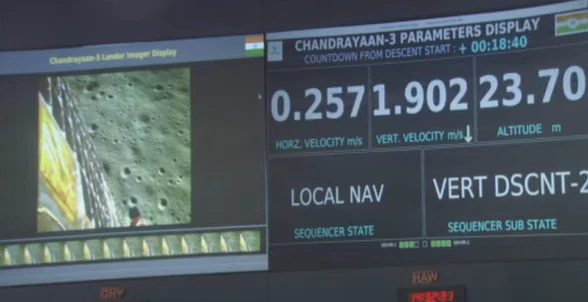India joined one of the solar system's most exclusive clubs today as it successfully landed its first probe, Chandrayaan-3, on the Moon. On August 23, 2023, at 12:32 GMT, the robotic spacecraft touched down near the lunar south pole at 69.37°S 32.35°E, making it the southernmost landing to date.
Today's successful landing of Chandrayaan-3 comes after over a month of anxious anticipation. The previous mission, Chandrayaan-2, crashed due to an unexpected attitude change during a coasting phase to take pictures of the landing area. By removing this coast phase and making other improvements, the Indian space agency, ISRO, hoped to improve the chances of a successful second attempt, which proved to be the case.
Launched from the Satish Dhawan Space Centre in Sriharikota Range on July 14, Chandrayaan-3 took what might be called the cosmic scenic route to the Moon. Because of the relatively large spacecraft and the relatively small booster, the Vikram lander and its propulsion module had to make a series of orbital maneuvers that gradually increased its orbit around the Earth before reaching lunar orbit on August 5. This was followed by more maneuvers to bring the probe closer to the Moon so it could effect a landing.
In something of an economy step, Chandrayaan-3 made contact with the orbiter from Chandrayaan-2 as a communications link to Mission Control.
After separation of the Vikram lander from the propulsion module, the landing began with the firing of the lander's braking thrusters at an altitude of 19 miles (30 km) above the lunar surface. At 4.5 miles (7.2 km), the lander hovered as it stabilized itself for landing using eight attitude control thrusters. Using two of its main engines, it descended to 500 ft (150 m) for a final 30-second hover while its automatic system assessed the safety of the landing site, before making touchdown near Manzius crater.
Once system checks are completed, the Vikram lander will deploy the solar-powered Pragyan rover, which will seek out signs of water in the vicinity. Because neither spacecraft is equipped with a nuclear heating system, the mission will only last until the end of the 14-day Moon day. After this, the extreme cold of the lunar night will damage the onboard batteries and electronics beyond repair.
The video below recaps the landing of Chandrayaan-3.
Source: ISRO





